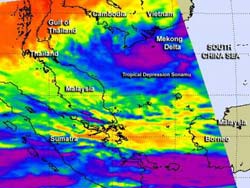NASA watches a slow-moving Tropical Depression Sonamu

This AIRS infrared image of Tropical Depression Sonamu on Jan. 8 at 1:41 a.m. EST, showed some very cold cloud top temperatures (purple) of -63F (-52C) existed, indicating there was still some strong convection occurring.<br><br>Credit: NASA JPL, Ed Olsen<br>
When NASA's Aqua satellite passed over Tropical Depression Sonamu on Jan. 8 at 0641 UTC (1:41 a.m. EST/U.S.), the Atmospheric Infrared Sounder (AIRS) instrument aboard took an infrared look at the storm.
AIRS data showed that Sonamu still contained some very cold cloud top temperatures of -63F (-52C) indicating there was still some strong convection occurring near the center of circulation. The strongest storms were located southwest of the Mekong Delta at the time of the satellite image.
Multispectral satellite imagery showed that the low level circulation center was exposed to outside winds, and that the center was disorganized.
By 1500 UTC (10 a.m. EST/U.S.), Sonamu's maximum sustained winds were near 30 knots (34.5 mph/55.5 kph). Sonamu was centered near 5.3 north latitude and 109.3 east longitude, about 335 nautical miles (385.5 miles/620.4 km) west of Brunei. It was drifting to the southeast at 3 knots (3.4 mph/5.5 kph).
Sonamu is expected to continue its slow movement to the southeast and weaken further as wind shear increases. The Joint Typhoon Warning Center expects that Sonamu will make a landfall sometime on Jan. 10 in the Malaysian part of Borneo.
Media Contact
More Information:
http://www.nasa.govAll latest news from the category: Earth Sciences
Earth Sciences (also referred to as Geosciences), which deals with basic issues surrounding our planet, plays a vital role in the area of energy and raw materials supply.
Earth Sciences comprises subjects such as geology, geography, geological informatics, paleontology, mineralogy, petrography, crystallography, geophysics, geodesy, glaciology, cartography, photogrammetry, meteorology and seismology, early-warning systems, earthquake research and polar research.
Newest articles

Security vulnerability in browser interface
… allows computer access via graphics card. Researchers at Graz University of Technology were successful with three different side-channel attacks on graphics cards via the WebGPU browser interface. The attacks…

A closer look at mechanochemistry
Ferdi Schüth and his team at the Max Planck Institut für Kohlenforschung in Mülheim/Germany have been studying the phenomena of mechanochemistry for several years. But what actually happens at the…

Severe Vulnerabilities Discovered in Software to Protect Internet Routing
A research team from the National Research Center for Applied Cybersecurity ATHENE led by Prof. Dr. Haya Schulmann has uncovered 18 vulnerabilities in crucial software components of Resource Public Key…




















